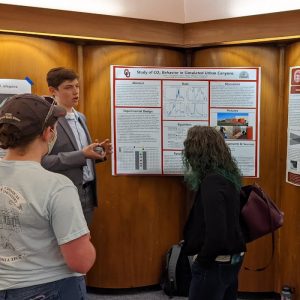Lucas Livingstone’s Research
In Fall 2021 and Spring 2022, Lucas Livingstone participated in the OU First Year Research Engagement (FYRE) program. Lucas, a Petroleum Engineering student at OU, performed research with me at the Outdoor Urban Air Quality Testing Lab (OU AQTLab). I have previously discussed the research with Lee Fithian at AQTLab on this blog. A summary of the work, presented by Lucas Livingstone entitled “Study of CO2 Behavior in Simulated Urban Canyons” was presented to the FYRE program yearly poster event. Lucas shared his findings not only to his freshman cohort, but he also shared it with his graduate and postdoctoral colleagues.

How Much is Enough?
Sadly, I’m not ready to share Lucas’ work here. It was excellent, but we are in the process of applying for funding based on his findings, and we hope to turn it into a paper. Lucas collected the initial data for trace gas measurement at the AQTLab by performing controlled releases. He studied how sensor geometry in the canyon impacts the limit of detection of that sensor. Notably, Lucas found how much carbon dioxide is required to register a response on our sensors when the gas is generated inside vs. outside the canyon. This has been studied before, but only in small wind tunnels. With this, we can scale up similar studies using the OU AQTLab. So how much gas was required? I will speak vaguely in terms of our high-tech carbon dioxide production tools. From inside the canyon, we can measure the gas from a number of Tiki torches. From outside the canyon….let’s just say I made the biggest science fair volcano you’ve ever seen.
So congratulations to Lucas Livingstone. I was so pleased with his ability, I kept him around! When I heard my group at GeoCarb was looking for a new undergrad researcher, I had to say “I know a good candidate!” Now he is working on bigger and better projects with our group. We have been in talks to expand on this research. This semester, I have a new FYRE student working with me on a similar project. Additionally, this work was the first step I took on the new work with other collaborators. With luck, we will have the funding to continue Lucas’ work soon.